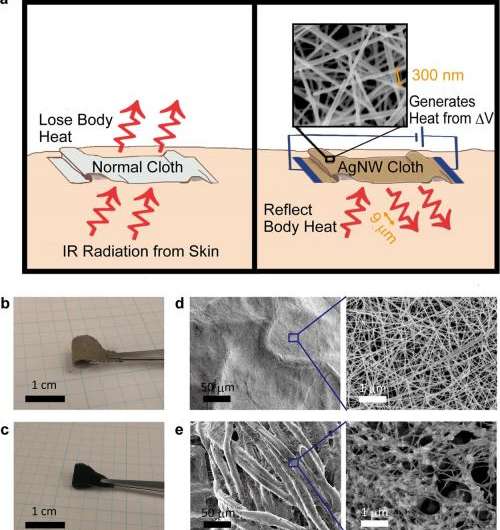January 8, 2015 feature
Super-insulated clothing could eliminate need for indoor heating

(Phys.org)—By wearing clothes that have been dip-coated in a silver nanowire (AgNW) solution that is highly radiation-insulating, a person may stay so warm in the winter that they can greatly reduce or even eliminate their need for heating their home. Considering that 47% of global energy is spent on indoor heating, and 42% of that specifically for residential heating, such highly insulating clothing could potentially have huge cost savings.
A team of researchers led by Professor Yi Cui, along with PhD student Po-Chun Hsu and others at Stanford University, have published a paper on the AgNW-coated textiles in a recent issue of Nano Letters.
As the researchers explain, most strategies to reduce indoor heating focus on improving the insulation of the buildings, such as by using high R-value insulation and low-emissivity windows. However, a large portion of the energy is still wasted on heating empty space and inanimate objects.
To avoid this waste, the researchers have used a new strategy called "personal thermal management," which focuses on heating people. They've demonstrated that clothing dipped in a solution of metallic nanowires, such as AgNWs, achieves this goal by both providing passive insulation and allowing for active heating when connected to an external power source.
The main advantage of the AgNW-coated clothing is that it reflects over 90% of an individual's body heat (i.e., infrared radiation) back to the individual. This reflectance is much higher than even the warmest wool sweater, as the average clothing material reflects back only about 20% of body heat.
This increase in reflectance is due to differences in the materials' emissivity, which is a measure of heat radiation. Low-emissivity materials like silver, which has an emissivity of 0.02, emit less radiation and so provide much better insulation than high-emissivity materials like common textiles, which have an emissivity of about 0.8.
Of course, wearing clothing made completely of silver would be impractical and uncomfortable, not to mention expensive. A main reason for this discomfort is that silver, like all metals, is not breathable. For example, Mylar blankets, which are made of aluminum and plastic, are extremely warm but are not vapor-permeable, causing moisture to accumulate on a person's skin.
The new AgNW-coated clothing, on the other hand, is breathable due to the nanowires' porous structure. The large spacing between nanowires of about 300 nm offers plenty of room for water vapor molecules, which are about 0.2 nm, to pass through. The 300-nm spacing is still much too small to allow body heat to pass through, since human body radiation has a wavelength of about 9 µm and so interacts with the nanowire cloth as if it were a continuous metal film, and is reflected.
Clothing coated in AgNWs would feel virtually identical to normal clothing because such a small amount of AgNW solution is required to achieve high reflectivity. Dip-coating cotton cloth into the AgNW solution adds a mass of just 0.1 g/m2, which would be less than 1 gram for an entire outfit. Only a small fraction of this mass is silver, so the cost would be relatively inexpensive. Using other metals such as copper, nickel, or aluminum, which have similar properties as silver, could further reduce costs.
Besides providing high levels of passive insulation, AgNW-coated clothing can also provide Joule heating if connected to an electricity source, such as a battery. The researchers demonstrated that as little as 0.9 V can safely raise clothing temperature to 38 °C, which is 1 °C higher than the human body temperature of 37 °C.
Variables such as outdoor temperature, length of the winter season, and home size make it difficult to calculate exactly how much energy a person would save by wearing AgNW-coated clothing. However, the researchers have calculated a rough savings estimate of 8.5 kWh of heating energy per person per day, or 1,000 kWh per year assuming that the heating system operates for four months per year. This estimate is based on the average person requiring 367 W of heating power, compared with 12 W required by the AgNW-coating clothing when actively operating.
The researchers note that a 1,000 kWh savings in power consumption is equivalent to the power generated by a 2-square-meter solar panel. Plus, fabrication, installation, and maintenance of the solar panel would likely cost much more than the AgNW-coated clothing.
When testing the durability of the AgNW-coated clothing, the researchers found that the clothing could withstand multiple wash cycles while maintaining its electrical properties. Surprisingly, the electrical resistance decreased after the first two wash cycles, possibly due to the removal of extra coating on AgNWs and an increase in packing density of the nanowire mesh, and the resistance stabilized after the third wash cycle.
The researchers also fabricated and tested clothing coated in a carbon nanotube solution. However, although carbon nanotubes are conductive and therefore suitable for Joule heating, their high emissivity of 0.98 does not enable them to reflect body heat nearly as well as the AgNW coating.
More information: Po-Chun Hsu, et al. "Personal Thermal Management by Metallic Nanowire-Coated Textile." Nano Letters. DOI: 10.1021/nl5036572
Journal information: Nano Letters
© 2015 Phys.org



















